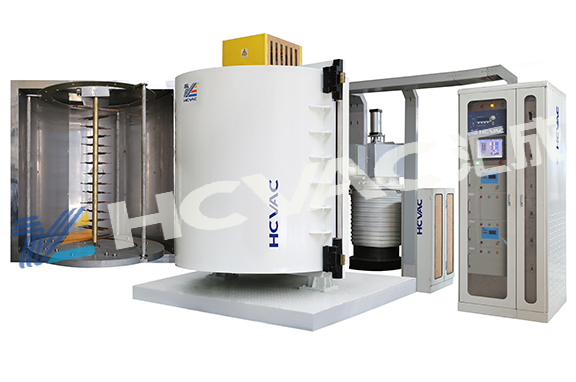Vacuum coating machine ion nitriding (commonly known as ion nitriding) is a surface chemical heat treatment process for nitriding by using the glow discharge generated between the workpiece (cathode) and the anode in a low vacuum (≤2000Pa) nitrogen-containing atmosphere. In order to reasonably select the labor, correctly carry out the process operation, properly adjust the control, and even transform and develop the ion nitriding equipment, it is necessary to master some basic knowledge of vacuum technology (such as the physical concept of vacuum, vacuum acquisition and measurement methods, etc.) .

Section 1 The concept of vacuum and degree of vacuum
In vacuum technology, the gas state of low and one atmospheric pressure is collectively referred to as vacuum. This is a rarer gas state than normal atmospheric pressure. The thinness of the residual gas in the vacuum is the degree of vacuum, that is, the degree of vacuum.
Section 2 The unit of vacuum degree and the division of vacuum area
The unit of vacuum
According to the definition of vacuum degree, the most direct physical quantity to measure vacuum degree is the number of molecules per unit volume, but due to historical and technical reasons, the degree of vacuum degree is expressed by the absolute pressure of the residual gas being evacuated. . "Pressure" refers to the pressure on the wall of the container per unit area. It is a physical quantity commonly used in the world to express the degree of vacuum. In 1958, the first international technical conference proposed to use "Torr" as a measure of vacuum degree. The unit is defined as "1Torr is 1/760 of 1 atmosphere", because 1 atmosphere is 760mmHg, so Torr can be used in common with mmHg. The unit of pressure specified in the International System of Units (SI) is (Pa), and Pa (Pa) is a special name for Newton/meter 2 (N/m2). At present, many countries including my country have gradually replaced Torr with Pa as the standard basic unit of vacuum pressure.
The higher the vacuum degree, the lower the gas pressure, and the smaller the number of gas molecules in the furnace. On the contrary, the higher the gas pressure, the lower the vacuum degree. It can be seen that the magnitude of the pressure is inversely proportional to the degree of vacuum.
In various literatures, in addition to Pa and Torr, the units of pressure include standard atmospheric pressure, bar, and kgf/cm2. The conversion relationship between several common units is shown in (Formula 1-1).
1Torr=133.3Pa
1Pa=75×10-3Torr
1Torr=1mmHg
1Torr=1/760 atmospheric pressure (Formula 1-1)
Second, the division of the vacuum area
There are many ways to divide the vacuum area. At present, my country divides the vacuum area into: low vacuum, medium vacuum, high vacuum and ultra-high vacuum. The vacuum values corresponding to each vacuum region are:
Low vacuum: 105~102Pa (760~1Torr)
Medium vacuum: 102~10-1Pa (1~10-3Torr)
High vacuum: 10-1~10-5Pa (10-3~10-7Torr)
Ultra-high vacuum: ≤10-5Pa (≤10-5Torr)
The physical phenomena of molecular motion in different vacuum regions are different. Ion nitriding is carried out in low vacuum, and its pressure range is usually 7~103Pa.
Section 3 Measurement of Vacuum
First, the concept of vacuum measurement
Tools that measure the pressure of gases below atmospheric pressure are called vacuum gauges. The vacuum gauge can directly measure the pressure of the gas, or it can indirectly measure the pressure through the physical quantity related to the pressure. The former is called an absolute vacuum gauge and the latter is called a relative vacuum gauge.
2. Introduction of commonly used vacuum gauges
There are many types of vacuum gauges. The following briefly introduces several vacuum gauges commonly used in domestic ion nitriding equipment.
1. Compression vacuum gauge
Compression vacuum gauge, also known as McLaws vacuum gauge, referred to as wheat vacuum gauge. Wheat vacuum gauges belong to the category of absolute vacuum gauges. The advantage is that the measurement accuracy is high, and it can be used as a standard for vacuum measurement.
2. Resistive vacuum gauge
The resistance vacuum gauge of the
vacuum coating machine is a resistance vacuum gauge manufactured by using the principle that the number of molecules in the vacuum system is related to the conduction heat, which belongs to the category of relative vacuum gauge.
The advantages of the resistance vacuum gauge lie in its simple structure, continuous measurement, total pressure measurement, and ease of use (long-distance measurement with wires). The disadvantage is that the measured value of this type of vacuum gauge is related to the type of gas to be measured. This is because most of this type of vacuum gauge is calibrated with air when leaving the factory. Due to the existence of hydrogen in the ion nitriding furnace, the thermal conductivity of hydrogen is related to nitrogen. Compared with the thermal conductivity of air, air, etc., the difference is too large, so the error of the measured vacuum degree value is large. However, because this type of vacuum gauge is practical and convenient, the reading is intuitive, and it has the courage to measure the ultimate vacuum degree and pressure rise rate of the furnace body, it is accurate and reliable, so it is still the first choice for most enterprises in my country.
Section 4 Obtaining a Vacuum——Vacuum Pump
A vacuum pump is a device that generates, improves and maintains a vacuum. According to the different working principles of obtaining vacuum, it can be divided into various types.



